The Continental Drift Theory: Revolutionary and Significant
- Plate Tectonics
- Types Of Rocks
- Landforms and Geologic Features
- Weather & Climate

Opposition to Continental Drift Theory
Data supporting continental drift theory.
- Wegener's Search for Scientific Truth
Acceptance of Continental Drift Theory
- MLA, Harvard Graduate School of Design
Continental drift was a revolutionary scientific theory developed in the years 1908-1912 by Alfred Wegener (1880-1930), a German meteorologist, climatologist, and geophysicist, that put forth the hypothesis that the continents had all originally been a part of one enormous landmass or supercontinent about 240 million years ago before breaking apart and drifting to their current locations. Based on the work of previous scientists who had theorized about horizontal movement of the continents over the Earth's surface during different periods of geologic time, and based on his own observations drawing from different fields of science, Wegener postulated that about 200 million years ago, a supercontinent that he called Pangaea (which means "all lands" in Greek) began to break up. Over millions of years the pieces separated, first into two smaller supercontinents, Laurasia and Gondwanaland, during the Jurassic period and then by the end of the Cretaceous period into the continents we know today.
Wegener first presented his ideas in 1912 and then published them in 1915 in his controversial book, "The Origins of Continents and Oceans , " which was received with great skepticism and even hostility. He revised and published subsequent editions of his book in 1920,1922, and 1929. The book (Dover translation of the 1929 fourth German edition) is still available today on Amazon and elsewhere.
Wegener's theory, although not completely correct, and by his own admission, incomplete, sought to explain why similar species of animals and plants, fossil remains, and rock formations exist on disparate lands separated by great distances of sea. It was an important and influential step that ultimately led to the development of the theory of plate tectonics , which is how scientists understand the structure, history, and dynamics of the Earth’s crust.
There was much opposition to Wegener's theory for several reasons. For one, he was not an expert in the field of science in which he was making a hypothesis , and for another, his radical theory threatened conventional and accepted ideas of the time. Furthermore, because he was making observations that were multidisciplinary, there were more scientists to find fault with them.
There were also alternative theories to counter Wegener’s continental drift theory. A commonly held theory to explain the presence of fossils on disparate lands was that there was once a network of land bridges connecting the continents that had sunk into the sea as part of a general cooling and contraction of the earth. Wegener, however, refuted this theory maintaining that continents were made of a less dense rock than that of the deep-sea floor and so would have risen to the surface again once the force weighing them down had been lifted. Since this had not occurred, according to Wegener, the only logical alternative was that the continents themselves had been joined and had since drifted apart.
Another theory was that the fossils of temperate species found in the arctic regions were carried there by warm water currents. Scientists debunked these theories, but at the time they helped stall Wegener’s theory from gaining acceptance.
In addition, many of the geologists who were Wegener's contemporaries were contractionists. They believed that the Earth was in the process of cooling and shrinking, an idea they used to explain the formation of mountains, much like wrinkles on a prune. Wegener, though, pointed out that if this were true, mountains would be scattered evenly all over the Earth's surface rather than lined up in narrow bands, usually at the edge of a continent. He also offered a more plausible explanation for mountain ranges. He said they formed when the edge of a drifting continent crumpled and folded — as when India hit Asia and formed the Himalayas.
One of the biggest flaws of Wegener’s continental drift theory was that he did not have a viable explanation for how continental drift could have occurred. He proposed two different mechanisms, but each was weak and could be disproven. One was based on the centrifugal force caused by the rotation of the Earth, and the other was based on the tidal attraction of the sun and the moon.
Though much of what Wegener theorized was correct, the few things that were wrong were held against him and prevented him from seeing his theory accepted by the scientific community during his lifetime. However, what he got right paved the way for plate tectonics theory.
Fossil remains of similar organisms on widely disparate continents support the theories of continental drift and plate tectonics. Similar fossil remains, such as those of the Triassic land reptile Lystrosaurus and the fossil plant Glossopteris , exist in South America, Africa, India, Antarctica, and Australia, which were the continents comprising Gondwanaland, one of the supercontinents that broke off from Pangaea about 200 million years ago. Another fossil type, that of the ancient reptile Mesosaurus , is only found in southern Africa and South America. Mesosaurus was a freshwater reptile only one meter long that could not have swum the Atlantic Ocean, indicating that there was once a contiguous landmass that provided a habitat for it of freshwater lakes and rivers.
Wegener found evidence of tropical plant fossils and coal deposits in the frigid arctic near the North Pole, as well as evidence of glaciation on the plains of Africa, suggesting a different configuration and placement of the continents than their present one.
Wegener observed that the continents and their rock strata fit together like pieces of a jigsaw puzzle, particularly the east coast of South America and the west coast of Africa, specifically the Karoo strata in South Africa and Santa Catarina rocks in Brazil. South America and Africa were not the only continents with similar geology , though. Wegener discovered that the Appalachian Mountains of the eastern United States, for instance, were geologically related to the Caledonian Mountains of Scotland.
Wegener's Search for Scientific Truth
According to Wegener, scientists still did not appear to understand sufficiently that all earth sciences must contribute evidence toward unveiling the state of our planet in earlier times, and that the truth of the matter could only be reached by combing all this evidence. Only by combing the information furnished by all the earth sciences would there be hope to determine "truth," that is to say, to find the picture that sets out all the known facts in the best arrangement and that therefore has the highest degree of probability. Further, Wegener believed that scientists always need to be prepared for a possibility that a new discovery, no matter what science furnishes it, may modify the conclusions we draw.
Wegener had faith in his theory and persisted in using an interdisciplinary approach, drawing on the fields of geology, geography, biology, and paleontology, believing that to be the way to strengthen his case and to keep up the discussion about his theory. His book, "The Origins of Continents and Oceans , " also helped when it was published in multiple languages in 1922, which brought it worldwide and ongoing attention within the scientific community. When Wegener gained new information, he added to or revised his theory, and published new editions. He kept the discussion of the plausibility of the continental drift theory going until his untimely death in 1930 during a meteorologic expedition in Greenland.
The story of the continental drift theory and its contribution to scientific truth is a fascinating example of how the scientific process works and how scientific theory evolves. Science is based on hypothesis, theory, testing, and interpretation of data, but the interpretation can be skewed by the perspective of the scientist and his or her own field of specialty, or denial of facts altogether. As with any new theory or discovery, there are those who will resist it and those who embrace it. But through Wegener’s persistence, perseverance, and open-mindedness to the contributions of others, the theory of continental drift evolved into the widely accepted theory today of plate tectonics. With any great discovery it is through the sifting of data and facts contributed by multiple scientific sources, and ongoing refinements of the theory, that scientific truth emerges.
When Wegener died, discussion of continental drift died with him for a while. It was resurrected, however, with the study of seismology and further exploration of the ocean floors in the 1950s and 1960s that showed mid-ocean ridges, evidence in the seafloor of the Earth's changing magnetic field, and proof of seafloor spreading and mantle convection, leading to the theory of plate tectonics. This was the mechanism that was missing in Wegener's original theory of continental drift. By the late 1960s, plate tectonics was commonly accepted by geologists as accurate.
But the discovery of seafloor spreading disproved a part of Wegener's theory, because it wasn't just the continents that were moving through static oceans, as he had originally thought, but rather entire tectonic plates, consisting of the continents, ocean floors, and parts of the upper mantle. In a process similar to that of a conveyor belt, hot rock rises from the mid-ocean ridges and then sinks down as it cools and becomes denser, creating convection currents that cause movement of the tectonic plates.
The theories of continental drift and plate tectonics are the foundation of modern geology. Scientists believe that there were several supercontinents like Pangaea that formed and broke apart over the course of Earth's 4.5-billion year lifespan. Scientists also now recognize that Earth is constantly changing and that even today, the continents are still moving and changing. For example, the Himalayas, formed by the collision of the Indian plate and the Eurasian plate is still growing, because plate tectonics is still pushing the Indian plate into the Eurasian plate. We may even be heading toward the creation of another supercontinent in 75-80 million years due to the continued movement of tectonic plates.
But scientists are also realizing that plate tectonics does not work merely as a mechanical process but as a complex feedback system, with even things such as climate affecting the movement of the plates, creating yet another quiet revolution in the theory of plate tectonics variable in our understanding of our complex planet.
- 5 Different Ways of Classifying Volcanoes
- All About Supercontinents
- What Happens at Transform Boundaries?
- Divergent Plate Boundaries
- Introduction to Convergent Plate Boundaries
- Why the Earth's Crust Is So Important
- The World's Major Earthquake Zones
- Everything You Need to Know About the Lithosphere
- Magma Versus Lava: How It Melts, Rises, and Evolves
- Reverse, Strike-Slip, Oblique, and Normal Faults
- Measuring Plate Motion in Plate Tectonics
- What Is Subduction?
- What Is an Ophiolite?
- Plate Tectonics Defined: Triple Junction
- What Was the Biggest Volcanic Eruption in History?
- Drilling Into Faults
Continental Drift: The groundbreaking theory of moving continents
Continental drift theory introduced the idea of moving continents.
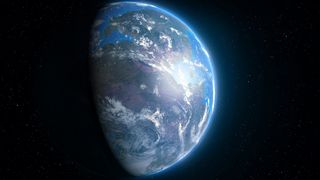
- Continental drift theory
Evolving theories
- Continental drift evidence
Additional resources
Continental drift was a revolutionary theory explaining that continents shift position on Earth's surface. The theory was proposed by geophysicist and meteorologist Alfred Wegener in 1912, but was rejected by mainstream science at the time. Scientists confirmed some of Wegener's ideas decades later, which are now part of the widely accepted theory of plate tectonics .
Wegener's continental drift theory introduced the idea of moving continents to geoscience. He proposed that Earth must have once been a single supercontinent before breaking up to form several different continents. This explained how similar rock formations and plant and animal fossils could exist on separated continents. Modern science recognizes this ancient supercontinent called Pangaea did exist before breaking up about 200 million years ago, as Wegener theorized.
Related: Massive supercontinent will form hundreds of millions of years from now
Why did scientists reject Wegener's continental drift theory?
Geologists roundly denounced Wegener's continental drift theory after he published the details in a 1915 book called " The Origin of Continents and Oceans ." Part of the opposition was because Wegener didn't have a good model to explain how the continents moved, something scientists later explained under the umbrella of plate tectonics — the theory that Earth's crust is fractured into plates that move over a rocky inner layer called the mantle .
"There's an irony that the key objection to continent drift was that there is no mechanism, and plate tectonics was accepted without a mechanism," to move the continents, Henry Frankel (1944–2019), an emeritus professor at the University of Missouri-Kansas City and author of the four volume " The Continental Drift Controversy " (Cambridge University Press, 2012) previously told Live Science.
Though most of Wegener's observations about fossils and rocks were correct, he was outlandishly wrong on a couple of key points. For instance, Wegener thought the continents might have plowed through the ocean crust like icebreakers smashing through ice.
When Wegener proposed continental drift, many geologists were contractionists. They thought Earth's incredible mountains were created because our planet had been cooling and shrinking since its formation, Frankel said. And to account for the identical fossils discovered on continents such as South America and Africa, scientists invoked ancient land bridges, now vanished beneath the sea.
Researchers argued over the land bridges right up until the plate tectonics theory was developed from the 1950s to the 1970s, Frankel said. For instance, as geophysicists began to realize that continental rocks were too light to sink down to the ocean floor, prominent paleontologists instead wrongly suggested that the similarities between fossils had been overestimated, Frankel said.
Plate tectonics is like a modern update to continental drift. In the 1960s, scientists discovered plate edges through magnetic surveys of the ocean floor and through the seismic listening networks built to monitor nuclear testing, according to Encyclopedia Britannica . Alternating patterns of magnetic anomalies on the ocean floor indicated seafloor spreading , where new plate material is born. Magnetic minerals aligned in ancient rocks on continents also showed that the continents have shifted relative to one another.
Related: Plate tectonics are 3.6 billion years old, oldest minerals on Earth reveal
What evidence is there for continental drift?

A map of the continents inspired Wegener's quest to explain Earth's geologic history. He was intrigued by the interlocking fit of Africa's and South America's shorelines. Wegener then assembled an impressive amount of continental drift evidence to show that Earth's continents were once connected in a single supercontinent.
Wegener knew that fossil plants and animals such as mesosaurs , a freshwater reptile found only in South America and Africa during the Permian period, could be found on many continents. He also matched up rock formations on either side of the Atlantic Ocean like puzzle pieces. For example, the Appalachian Mountains (United States) and Caledonian Mountains (Scotland) fit together, as do the Karoo strata in South Africa and Santa Catarina rocks in Brazil.
In fact, plates moving together created the highest mountains in the world, the Himalayans, and the mountains are still growing due to the plates pushing together, even now, according to National Geographic . Despite his incredible continental drift evidence, Wegener never lived to see his theory gain wider acceptance. He died in 1930 at age 50 just two days after his birthday while on a scientific expedition in Greenland , according to the University of Berkeley .
- Learn more about the history of continental drift and plate tectonics from the U.S. Geological Survey .
- Learn more about Alfred Wegener from the NASA Earth Observatory .
- Watch this short video on YouTube about plate tectonics and continental drift, from National Geographic .
This article was updated on Dec. 14, 2021, by Live Science Staff Writer Patrick Pester. Additional reporting by Alina Bradford, Live Science contributor.
Sign up for the Live Science daily newsletter now
Get the world’s most fascinating discoveries delivered straight to your inbox.
Yarlung Tsangpo: The deepest canyon on land hides a tree taller than the Statue of Liberty
Scientists drill longest-ever piece of Earth's mantle from underwater mountain near 'Lost City'
Newborns are colonized with antibiotic resistant bacteria
Most Popular
- 2 James Webb Space Telescope spies strange shapes above Jupiter's Great Red Spot
- 3 NASA offers SpaceX $843 million to destroy the International Space Station
- 4 Newly discovered asteroid larger than the Great Pyramid of Giza will zoom between Earth and the moon on Saturday
- 5 China opens Chang'e 6 return capsule containing samples from moon's far side
- 2 2,000 years ago, a bridge in Switzerland collapsed on top of Celtic sacrifice victims, new study suggests
- 3 Self-healing 'living skin' can make robots more humanlike — and it looks just as creepy as you'd expect
- 4 Tasselled wobbegong: The master of disguise that can eat a shark almost as big as itself
- 5 This robot could leap higher than the Statue of Liberty — if we ever build it properly
Plate Tectonics
Theory of continental drift.
The continental drift hypothesis was developed in the early part of the 20th century, mostly by Alfred Wegener. Wegener said that continents move around on Earth’s surface and that they were once joined together as a single supercontinent. While Wegener was alive, scientists did not believe that the continents could move.Find a map of the continents and cut each one out. Better yet, use a map where the edges of the continents show the continental shelf. That’s the true size and shape of a continent and many can be pieced together like a puzzle. The easiest link is between the eastern Americas and western Africa and Europe, but the rest can fit together too.
Alfred Wegener proposed that the continents were once united into a single supercontinent named Pangaea, meaning all earth in ancient Greek. He suggested that Pangaea broke up long ago and that the continents then moved to their current positions. He called his hypothesis continental drift.
Evidence for Continental Drift
Besides the way the continents fit together, Wegener and his supporters collected a great deal of evidence for the continental drift hypothesis. For one, identical rocks of the same type and age are found on both sides of the Atlantic Ocean. Wegener said the rocks had formed side-by-side and that the land had since moved apart.Mountain ranges with the same rock types, structures, and ages are now on opposite sides of the Atlantic Ocean. The Appalachians of the eastern United States and Canada, for example, are just like mountain ranges in eastern Greenland, Ireland, Great Britain, and Norway. Wegener concluded that they formed as a single mountain range that was separated as the continents drifted.Ancient fossils of the same species of extinct plants and animals are found in rocks of the same age but are on continents that are now widely separated. Wegener proposed that the organisms had lived side by side, but that the lands had moved apart after they were dead and fossilized. He suggested that the organisms would not have been able to travel across the oceans. For example, the fossils of the seed fern Glossopteris were too heavy to be carried so far by wind. The reptile Mesosaurus could only swim in fresh water. was a swimming reptile but could only swim in fresh water. Cynognathus and Lystrosaurus were land reptiles and were unable to swim.Grooves and rock deposits left by ancient glaciers are found today on different continents very close to the equator. This would indicate that the glaciers either formed in the middle of the ocean and/or covered most of the Earth. Today glaciers only form on land and nearer the poles. Wegener thought that the glaciers were centered over the southern land mass close to the South Pole and the continents moved to their present positions later on.Coral reefs and coal-forming swamps are found in tropical and subtropical environments, but ancient coal seams and coral reefs are found in locations where it is much too cold today. Wegener suggested that these creatures were alive in warm climate zones and that the fossils and coal later had drifted to new locations on the continents.Although Wegener’s evidence was sound, most geologists at the time rejected his hypothesis of continental drift. Scientists argued that there was no way to explain how solid continents could plow through solid oceanic crust. Wegener’s idea was nearly forgotten until technological advances presented even more evidence that the continents moved and gave scientists the tools to develop a mechanism for Wegener’s drifting continents.
Magnetic Polarity on the Same Continent with Rocks of Different Ages
Magnetic polarity on different continents with rocks of the same age.
- Dynamic Earth: Introduction to Physical Geography. Authored by : R. Adam Dastrup. Located at : http://www.opengeography.org/physical-geography.html . Project : Open Geography Education. License : CC BY-SA: Attribution-ShareAlike
- Fossil Map. Authored by : Osvaldocangaspadilla. Provided by : USGS. Located at : https://commons.wikimedia.org/wiki/File:Snider-Pellegrini_Wegener_fossil_map.svg . License : Public Domain: No Known Copyright
Continental Drift versus Plate Tectonics
A scientific idea that was initially ridiculed paved the way for the theory of plate tectonics, which explains how Earth’s continents move.
Earth Science, Geology, Geography, Physical Geography
Alfred Wegener in Greenland
Plate tectonics is the theory that Earth's land masses are in constant motion. The realization that Earth's land masses move was first proposed by Alfred Wegener, which he called continental drift. He is shown here in Greenland.
Photograph from Pictoral Press
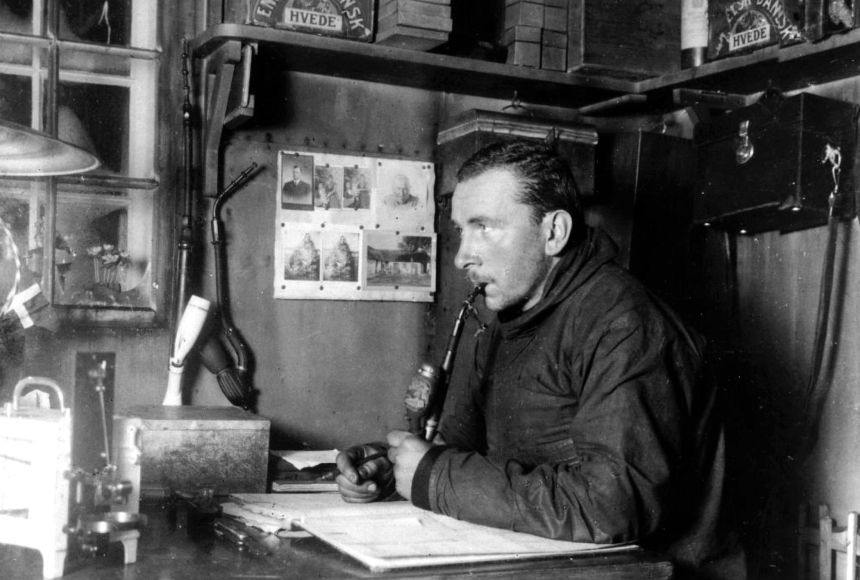
We don’t perceive that the continents we live on are moving. After all, it’s not as if an airplane flight between Europe and Africa takes five hours one year but only three hours the next. But the continents actually are shifting, very slowly, relative to one another. In the early 20th century, a scientific theory called continental drift was proposed about this migration of the continents . That theory was initially ridiculed, but it paved the way for another theory called plate tectonics that scientists have now accepted to explain how Earth’s continents move. The story begins with Alfred Wegener (1880–1930), a German meteorologist and geophysicist who noticed something curious when he looked at a map of the world. Wegener observed that the continents of South America and Africa looked like they would fit together remarkably well—take away the Atlantic Ocean and these two massive landforms would lock neatly together. He also noted that similar fossils were found on continents separated by oceans, additional evidence that perhaps the landforms had once been joined. He hypothesized that all of the modern-day continents had previously been clumped together in a super continent he called Pangaea (from ancient Greek, meaning “all lands” or “all the Earth”). Over millions of years, Wegener suggested, the continents had drifted apart. He did not know what drove this movement, however. Wegener first presented his idea of continental drift in 1912, but it was widely ridiculed and soon, mostly, forgotten. Wegener never lived to see his theory accepted—he died at the age of 50 while on an expedition in Greenland. Only decades later, in the 1960s, did the idea of continental drift resurface. That’s when technologies adapted from warfare made it possible to more thoroughly study Earth. Those advances included seismometers used to monitor ground shaking caused by nuclear testing and magnetometers to detect submarines. With seismometers , researchers discovered that earthquakes tended to occur in specific places rather than equally all over Earth. And scientists studying the seafloor with magnetometers found evidence of surprising magnetic variations near undersea ridges: alternating stripes of rock recorded a flip-flopping of Earth’s magnetic field . Together, these observations were consistent with a new theory proposed by researchers who built on Wegener’s original idea of continental drift —the theory of plate tectonics . According to this theory , Earth’s crust is broken into roughly 20 sections called tectonic plates on which the continents ride. When these plates press together and then move suddenly, energy is released in the form of earthquakes. That is why earthquakes do not occur everywhere on Earth—they’re clustered around the boundaries of tectonic plates. Plate tectonics also explains the stripes of rock on the seafloor with alternating magnetic properties: As buoyant, molten rock rises up from deep within Earth, it emerges from the space between spreading tectonic plates and hardens, creating a ridge. Because some minerals within rocks record the orientation of Earth’s magnetic poles and this orientation flips every 100,000 years or so, rocks near ocean ridges exhibit alternating magnetic stripes. Plate tectonics explains why Earth’s continents are moving; the theory of continental drift did not provide an explanation. Therefore, the theory of plate tectonics is more complete. It has gained widespread acceptance among scientists. This shift from one theory to another is an example of the scientific process: As more observations are made and measurements are collected, scientists revise their theories to be more accurate and consistent with the natural world. By running computer simulations of how Earth’s tectonic plates are moving, researchers can estimate where the planet's continents will likely be in the future. Because tectonic plates move very slowly—only a few centimeters per year, on average—it takes a long time to observe changes. Scientists have found that the planet’s continents will likely again be joined together in about 250 million years. Researchers have dubbed this future continental configuration “ Pangaea Proxima.” One intriguing aspect of Pangaea Proxima is that it will likely contain a new mountain range with some of the world’s highest mountains. That is because as Africa continues to migrate north it will collide with Europe, a collision that will probably create a Himalaya-scale mountain range. However, Christopher Scotese, one of the scientists who developed these simulations , cautions that it is difficult to predict exactly how the continents will be arranged in millions of years. “We don’t really know the future, obviously,” Scotese told NASA. “All we can do is make predictions of how plate motions will continue, what new things might happen, and where it will all end up.”
Articles & Profiles
Media credits.
The audio, illustrations, photos, and videos are credited beneath the media asset, except for promotional images, which generally link to another page that contains the media credit. The Rights Holder for media is the person or group credited.
Production Managers
Program specialists, last updated.
March 7, 2024
User Permissions
For information on user permissions, please read our Terms of Service. If you have questions about how to cite anything on our website in your project or classroom presentation, please contact your teacher. They will best know the preferred format. When you reach out to them, you will need the page title, URL, and the date you accessed the resource.
If a media asset is downloadable, a download button appears in the corner of the media viewer. If no button appears, you cannot download or save the media.
Text on this page is printable and can be used according to our Terms of Service .
Interactives
Any interactives on this page can only be played while you are visiting our website. You cannot download interactives.
Related Resources
- 0 Shopping Cart

What is Continental Drift?
In 1912, Alfred Wegener published a theory to explain why the Earth looked like a huge jigsaw. He believed the continents were once joined, forming a supercontinent he called Pangaea. Over 180 million years ago, this supercontinent began to “break up” due to continental drift.
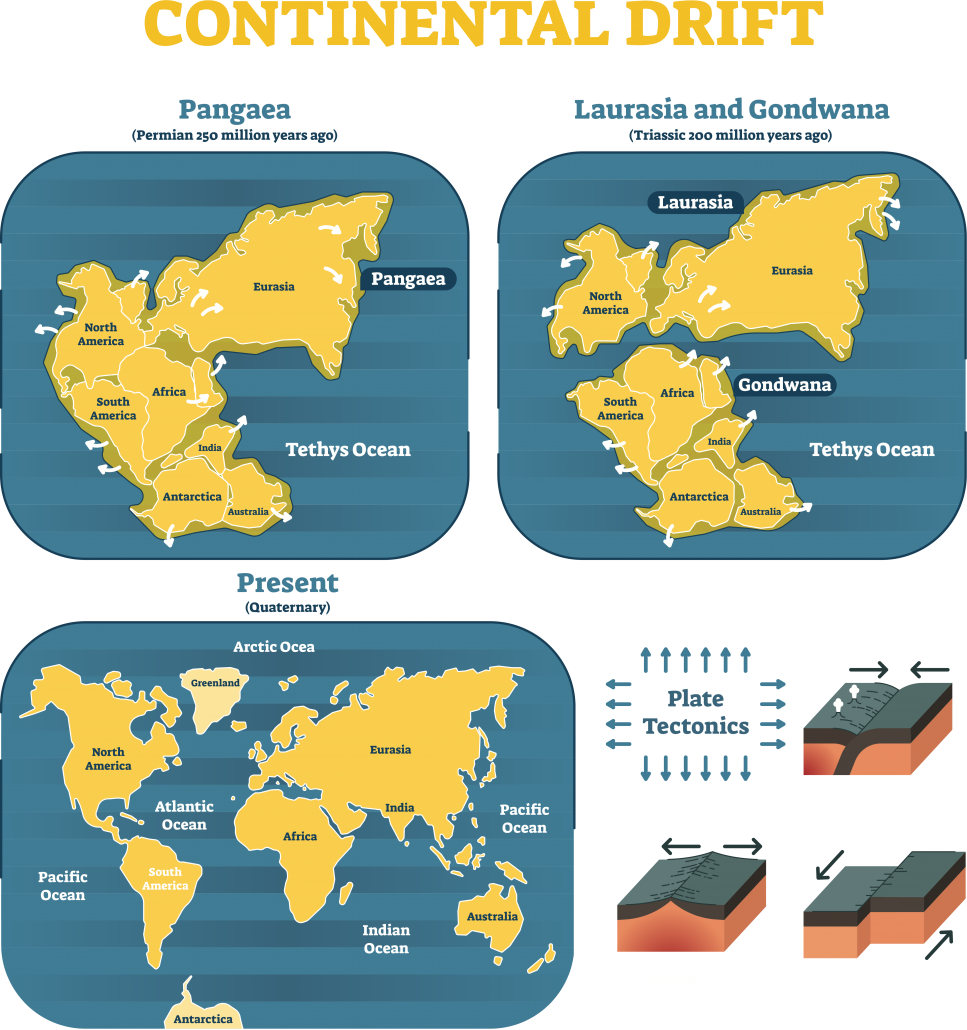
Continental drift
During the 20th Century, scientists developed the theory of Plate Tectonics. The theory suggests that the crust of the Earth is split up into seven large plates (see map below) and a few smaller ones, all of which can slowly move around on the Earth’s surface. They lie on the ductile mantle that allows them to move. There are several explanations for the movement of the Earth’s plates, and these are explored in the Why do plates move? page.
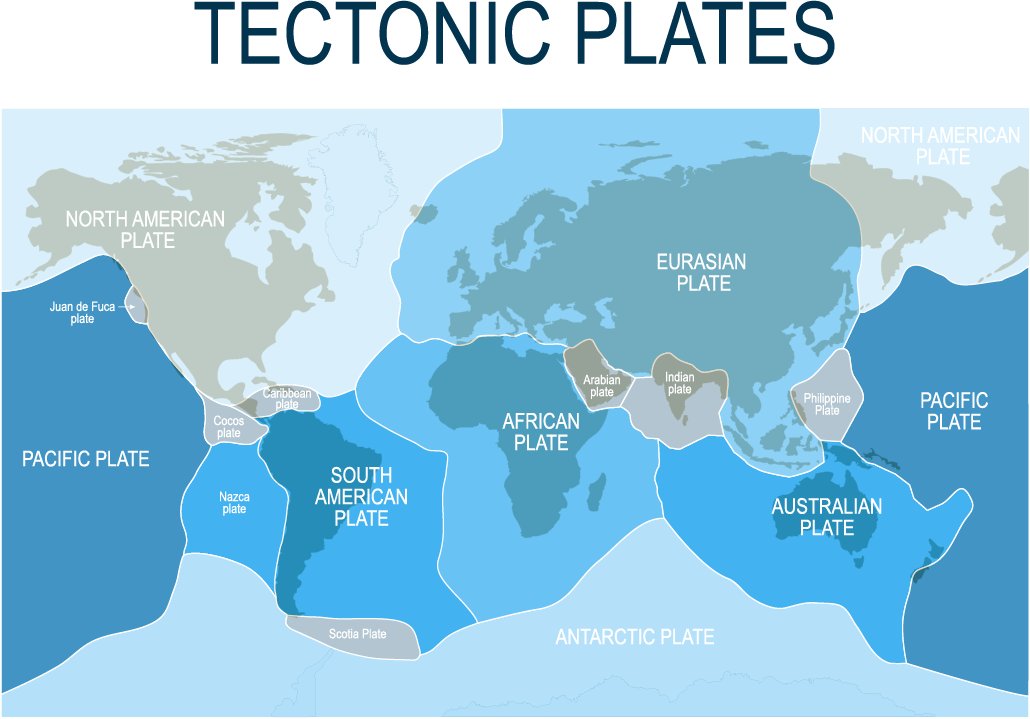
The Earth’s main tectonic plates
What is the evidence for continental drift?
Wegener’s evidence for continental drift was that:
- the same types of fossilised plants and animals are found in South America and Africa;
- the east coast of South America fits the west coast of Africa like a jigsaw puzzle;
- rock formations and mountain chains match in South America and Africa;
- similar mineral deposits and natural resources, such as coal, exist along the east coast of Africa and the west coast of South America.

Premium Resources
Please support internet geography.
If you've found the resources on this page useful please consider making a secure donation via PayPal to support the development of the site. The site is self-funded and your support is really appreciated.
Related Topics
Use the images below to explore related GeoTopics.
Plate boundaries
Topic home, why do plates move, share this:.
- Click to share on Twitter (Opens in new window)
- Click to share on Facebook (Opens in new window)
- Click to share on Pinterest (Opens in new window)
- Click to email a link to a friend (Opens in new window)
- Click to share on WhatsApp (Opens in new window)
- Click to print (Opens in new window)
If you've found the resources on this site useful please consider making a secure donation via PayPal to support the development of the site. The site is self-funded and your support is really appreciated.
Search Internet Geography
Latest Blog Entries
Pin It on Pinterest
- Click to share
- Print Friendly

Theory of Continental Drift: Causes and Evidence

If you take a look at a map of the earth today, you will see the current locations of broken land masses that constitute the earth. However, would you believe if someone told you that these broken land masses were once connected to each other as one huge supercontinent? Well, this claim was made in the 90’s by Alfred Wegener , a German polar researcher, meteorologist and geophysicist who died in 1930.
Wegener’s theory of continental drift states that the existing continents of the earth were once glued together forming a super landmass. Over time, the landmass broke and drifted away and is still drifting to this day. In his proposal, he stated that the super content, which he named Pangaea, meaning ‘’all earth” once existed. The supercontinent was surrounded by water bodies, mainly oceans, and seas.
As a result of movement of the supercontinent, Pangaea split into two super landmasses namely Laurasia and Gondwanaland. Laurasia, makes up the northern continents of today. The northern continent consists of Europe, North America, and Asia. Gondwanaland makes up the southern continents of today. The southern continent consists of South America, Antarctica, Australia, India, and Africa. While making this claim, he had a collection of evidence to support it.
Causes of Continental Drift
The causes of continental drift are perfectly explained by the plate tectonic theory . The earth’s outer shell is composed of plates that move a little bit every year. Heat coming from the interior of the earth triggers this movement to occur through convection currents inside the mantle. Over the course of millions of year ago, this gradual movement caused the once combined supercontinent to separate into 7 continents you witness in the present day.
Almost all plate movement occurs in boundaries which lie between different plates. When plates drift away from each other, there is formation of new crust at divergent boundaries. On the other hand, tectonic movement destroys crust during interaction of the plates. Destruction happens when one plate moves below the other at convergent boundaries. However, the crust is never destroyed when plates move past one another horizontally at transform boundaries.
Continental drift has impacted the universe in many ways. It has affected the global climate, the world’s geographical positions and the evolution of animals. Continental drift also comes along with grave effects such as Volcanoes , Earthquakes, and Tsunamis . Through the theory of continental drift, humans have been able to figure out how the earth’s crust moves and the causes of volcanoes , earthquakes , oceanic trenches, formation of mountain ranges and other geological occurrences.
Evidence of Continental Drift Theory
Fossil plants and animals clue.
Fossils of creatures and plants discovered on different continents helped to him push his case that the continents were once locked together before breaking up and drifting away. Some of the fossil evidence discovered on the continents includes mesosaurus, lystosaurus, cygnognathus and glossopteris.
Mesosaurus are fossils originating from aquatic freshwater reptiles. These reptiles lived in freshwater bodies such as lakes and rivers. If you take a look at the map before the continents drifted away, you find that Mesosaurus is located in the southern parts of Africa and North America. If you look at the current map after the continents drifted away, you find that North America and Africa are far away from each other separated by the Atlantic Ocean .
So, his theory is proved by the fact that the freshwater reptiles could not swim across the ocean waters, hence, their distribution on every continent. The discovery of fossils on different continents indicated that the continents were once together before they drifted away.
- Lystrosaurus and Cygnognathus
Lystrosaurus is Fossil from land reptiles. Cygnognathus is Fossil from another species of reptile. If you look at the map before the continents drifted away, you find that Cygnognathus was situated in South America and Africa. Lystrosaurus, on the other hand, was located in Africa, India, and Antarctica. According to the Lystrosaurus and Cygnognathus’ body anatomy, they are not designed for swimming. Now, looking at the current map after drifting of the continents, Cygnognathus is situated in Africa and South America.
So, technically, the creature would not have traveled through the ocean to get to the next continent. The distribution of these reptiles in different continents proves that these separate land masses were once together before splitting. On top of that, Lystrosaurus is situated in Antarctica, India, and Africa according to the modern map. Again, for this creature to swim from Africa to Antarctica would have been impossible. So, the fact that these organisms could not swim through the vast water bodies helps to substantiate the fact that the continents were once together to allow distribution of these organisms in various continents where their fossils were found on.
- Glossopteris
Glossopteris was Fossil from fern. It is a fern that was discovered in Africa, South America, Antarctica, India, and Australia. According to the modern day map, these continents are far apart. It’s, therefore, impossible that the seeds of the fern were blown by wind or floated across the ocean to have that kind of population on these 5 continents . The fact that the seeds would have been unable to be blown or floated to these continents proves that these continents were once together.

Information from climate
Apart from fossil evidence, Wegener used climatic clues to substantiate his facts. One of the clues he used was the glacier. Wegener, in his expedition, discovered glacier grooves in all the continents. Glacier grooves are the gaping trenches or landmarks carved out by movement of glacier. He discovered glacier groves in continents that were not cold enough to support snow formation in the present day. When he brought these continents together, the glacier grooves perfectly matched up. This suggested that these continents were once together and drifted away over time.
The perfect fitting of continents
Wegener also provided evidence of continental drift by looking at the physical shape of continental coastlines. The shape of continental coastlines visibly matched up like pieces of the puzzle. For example, the continents of South America and Africa fit perfectly when brought together. This indicates that the continents were once fixed together and drifted apart over time.
Wegener specifically used rock composition and mountain ranges to provide evidence of continental drift. He provided evidence that mountain ranges occurring on opposite continents matched up pretty well when brought together. This perfect aligning of mountain ranges indicated that the continents were once together. For example, if you take the mountains ranges of North America and Europe, they align perfectly well. Mountains are typically formed when two opposite land masses collide with each other triggering the rock found at the point of collision to fold or bulge upwards.
In terms of rock composition, at locations where continents match up, the kinds of rocks on the opposite sides of the continents were of the same kind. Since these match up points consisted of the same kind of rock further proves that the continents were once together before breaking away and drifting.
Despite Wegener’s effort to try to prove his theory of continental drift, it was never accepted. When he was tasked with proving how these continents moved to different places, he couldn’t. However, this theory of continental drift came to be accepted in the 90’s after his death. He died of an alleged heart attacked when on an expedition to Greenland.
Photo by: pixabay
I am Sonia Madaan, a mother with a passion for science, computing, and environmental issues. Motivated by my passion and education, I started a website to spread awareness about climate change and its causes, like rising greenhouse gas levels. You can read more about me here .
Similar Posts
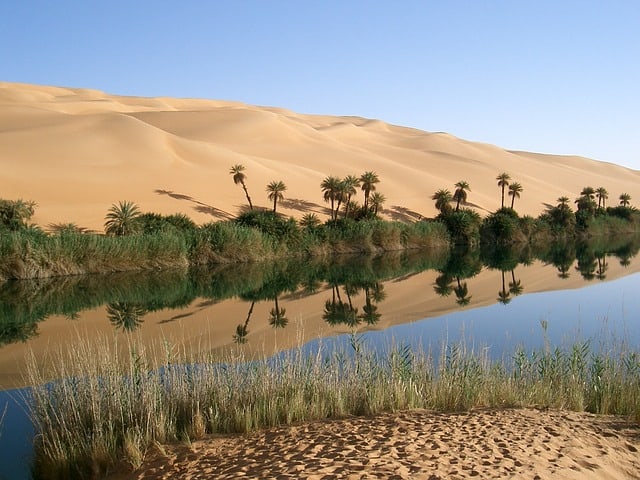
14 Different Types of Terrain That Can be Found on This Planet
The word Terrain originated from the Latin “Terra” which translates to Earth. The terrain is a word usually used when describing the lay of the land and maybe also be called Topography or relief. This word is most common among geographers, as they are known to study the various unique and different land surfaces found…
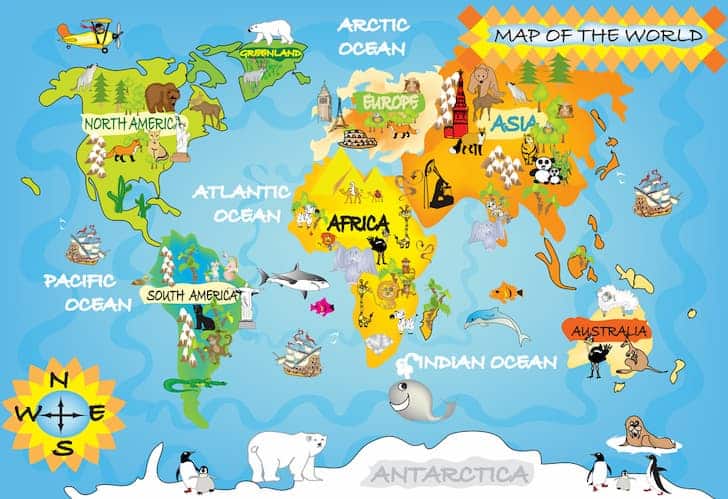
7 Continents of the World (Countries and Area Size)
The planet earth is made up of vast landmasses, which makes up where all human beings live. Among all the planets in the solar system, the earth offers the most diverse landmass features. These landmasses are known as continents covering 1/3rd area of the planet. According to the Pangaea Theory, the earth was originally one…
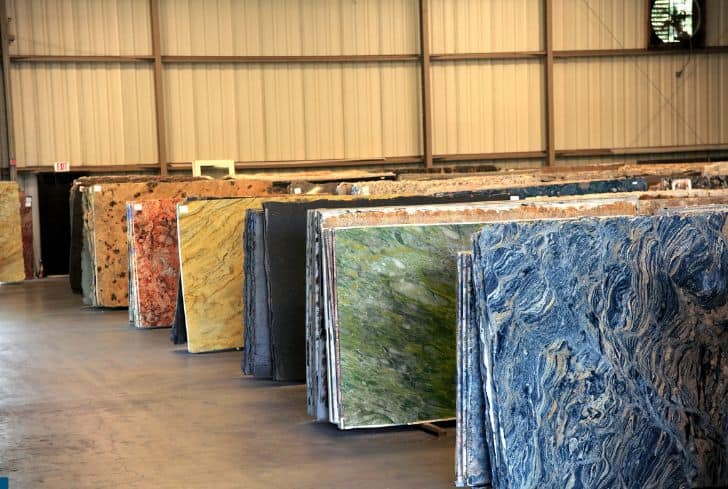
Does Granite Absorb Water? (And Heat?)
Granite is a common, coarse-grained or medium-grained natural stone. This hard igneous rock is strong, solid, and rich in quartz, orthoclase, microcline, mica and feldspar. The speckles of quartz in the stone give a dash of classy sparkle. Granite is the most common plutonic rock of the Earth’s crust, formed by the cooling of magma…
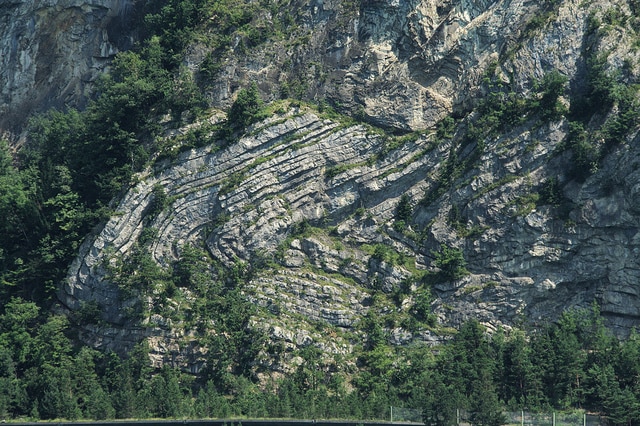
Types and Principles of Plate Tectonics Boundaries
Plate tectonics defines the movements and features of the Earth’s surface now and in the past. The theory of plate tectonics was advanced in the 1960s and 1970s to generate new information about the Earth’s ancient magnetism, the nature of the ocean floor, the flow of heat from the Earth’s interior, and earthquake and volcanic…
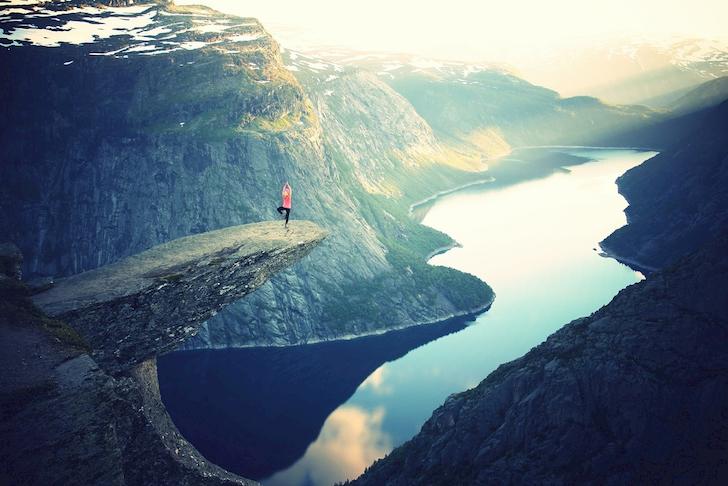
What is a Cliff? How are Cliffs Formed and 20 Magnificent Facts About the Cliffs
We have many times seen pictures of a huge mass of rock standing almost vertically along the ocean or riverbanks. These are nothing but cliffs, which are a common form of landscape. Cliffs are erosional landforms that usually exist in the form of vertical or nearly vertical rock exposures. A cliff is a high steep…

What is a Volcano and How are Volcanoes Formed?
A volcano is a fissure – opening or vent – in the earth’s crust through which molten rocks and gases erupt. The molten rocks can be in the form of mixture of hot gases, ash, lava, or other extremely hot substances within the earth’s crust. A volcano looks like a huge heap of soil or…
- Subscribe to BBC Science Focus Magazine
- Previous Issues
- Future tech
- Everyday science
- Planet Earth
- Newsletters
© Getty Images
Who really discovered continental drift?
It’s no coincidence that the continents seem to fit together like a puzzle, an observation made by more than one person throughout history...
Robert Matthews
In January 1912, the German meteorologist and explorer Alfred Wegener unveiled an astonishing new vision of the Earth’s past. According to Wegener, the world we see today is the result of the break-up of a colossal landmass into separate continents, which have been moving around ever since.
The theory of continental drift provoked outrage, despite the idea having been in circulation for centuries. As long ago as 1596, the Flemish mapmaker Abraham Ortelius had pointed out what doubtless others had already noticed: that the Americas and Africa seem to fit together like jigsaw pieces. He argued this was no coincidence, and that the Americas had been “torn away from Europe and Africa…by earthquakes and floods”. In 1858, the French geographer Antonio Snider-Pellegrini went further, pointing out that fossils of similar plants appeared on both sides of the Atlantic. Presaging Wegener, Snider-Pellegrini argued that there had once been a single landmass which had disintegrated, though he ascribed the cause to the biblical Great Flood.

Wegener himself never found a compelling explanation for the driving force of continental drift. But we now know it’s down to the roiling motion of vast convective loops of hot rock beneath the Earth’s shattered crust.
Subscribe to BBC Focus magazine for fascinating new Q&As every month and follow @sciencefocusQA on Twitter for your daily dose of fun science facts.
Share this article

- Terms & Conditions
- Privacy policy
- Cookies policy
- Code of conduct
- Magazine subscriptions
- Manage preferences

Alfred Wegener: Building a Case for Continental Drift

Alfred Wegener collected diverse pieces of evidence to support his theory, including geological “fit” and fossil evidence. It is important to know that the following specific fossil evidence was not brought up by Wegener to support his theory. Wegener himself did not collect the fossils but he called attention to the idea of using these scientific doc uments stating there were fossils of species present in separate continents in order to support his claim.
Illustration showing similar rock assemblages across different continents.
Geological “fit” evidence is the matching of large-scale geological features on different continents. It has been noted that the coastlines of South America and West Africa seem to match up, however more particularly the terrains of separate continents conform as well. Examples include: the Appalachian Mountains of eastern North America linked with the Scottish Highlands, the familiar rock strata of the Karroo system of South Africa matched correctly with the Santa Catarina system in Brazil, and the Brazil and Ghana mountain ranges agreeing over the Atlantic Ocean.
Another important piece of evidence in the Continental Drift theory is the fossil relevance. There are various examples of fossils found on separate continents and in no other regions. This indicates that these continents had to be once joined together because the extensive oceans between these land masses act as a type of barrier for fossil transfer. Four fossil examples include: the Mesosaurus, Cynognathus, Lystrosaurus, and Glossopteris.
Modern day representation of the Mesosaurus.
The Mesosaurus is known to have been a type of reptile, similar to the modern crocodile, which propelled itself through water with its long hind legs and limber tail. It lived during the early Permian period (286 to 258 million years ago) and its remains are found solely in South Africa and Eastern South America. Now if the continents were in still their present positions, there is no possibility that the Mesosaurus would have the capability to swim across such a large body of ocean as the Atlantic because it was a coastal animal.
Modern day representation of the Cynognathus.
The now extinct Cynognathus, which translates to “dog jaw”, was a mammal- like reptile. Roaming the terrains during the Triassic period (250 to 240 million years ago), the Cynognathus was as large as a modern wolf. Its fossils are found only in South Africa and South America. As a land dominant species, the Cynognathus would not have been capable of migrating across the Atlantic.
Modern day representation of the Lystrosaurus.
The Lystrosaurus, which translates to “shovel reptile,” is thought to have been an herbivore with a stout build like a pig. It is approximated that it grew up to one meter in length and was relatively dominant on land during the early Triassic period (250 million years ago). Lystrosaurus fossils are only found in Antarctica, India, and South Africa. Similar to the land dwelling Cynognathus, the Lystrosaurus would have not had the swimming capability to traverse any ocean.
Modern day representation of the Glossopteris.
Possibly the most important fossil evidence found is the plant, Glossopteris. Known as a woody, seed bearing tree, the Glossopteris is named after the Greek description for tongue due to its tongue shaped leaves and is the largest genus of the extinct descendant of seed ferns. Reaching as tall as 30 meters, the Glossopteris emerged during the early Permian period (299 million years ago) and became the dominant land plant species until the end of the Permian. The Glossopteris fossil is found in Australia, Antarctica, India, South Africa, and South America—all the southern continents. Now, the Glossopteris seed is known to be large and bulky and therefore could not have drifted or flown across the oceans to a separate continent. Therefore, the continents must have been joined at least one point in time in order to maintain the Glossopteris’ wide range across the southern continents.
Description showing the fossil locations of the Mesosaurus, Cynognathus, Lystrosaurus, and Glossopteris spread across different continents.
If the continents of the Southern Hemisphere are put together, the distribution of these four fossil types form continuous patterns across continental boundaries. Of course, possible explanations are brought to attention. One explanation is the species could have migrated via a land bridge or swam to the other continents. However, a land bridge is not applicable due to the differences in densities between the continents and oceans floor and violation of the isostasy concept. Moreover, swimming as a possibility is foolish due to the lack of formidable swimming capabilities to travel across such an extensive body of water like the Atlantic. An additional resolution is that the species could have merely evolved separately on the other continents. Undoubtedly, this interpretation is in complete disagreement with Darwin’s evolution theory.
Pardon Our Interruption
As you were browsing something about your browser made us think you were a bot. There are a few reasons this might happen:
- You've disabled JavaScript in your web browser.
- You're a power user moving through this website with super-human speed.
- You've disabled cookies in your web browser.
- A third-party browser plugin, such as Ghostery or NoScript, is preventing JavaScript from running. Additional information is available in this support article .
To regain access, please make sure that cookies and JavaScript are enabled before reloading the page.

- History & Society
- Science & Tech
- Biographies
- Animals & Nature
- Geography & Travel
- Arts & Culture
- Games & Quizzes
- On This Day
- One Good Fact
- New Articles
- Lifestyles & Social Issues
- Philosophy & Religion
- Politics, Law & Government
- World History
- Health & Medicine
- Browse Biographies
- Birds, Reptiles & Other Vertebrates
- Bugs, Mollusks & Other Invertebrates
- Environment
- Fossils & Geologic Time
- Entertainment & Pop Culture
- Sports & Recreation
- Visual Arts
- Demystified
- Image Galleries
- Infographics
- Top Questions
- Britannica Kids
- Saving Earth
- Space Next 50
- Student Center
What is the theory of continental drift?


- Energy & Resources
- Medical Research
- Resources: Astronomy, Astrophysics
- Resources: Earth Sciences, Climate Change, Environment
- Resources: Energy and Resources
- Resources: Life
- Resources: Medical Research
- Resources: Science Literacy
- Lecture Series 2009
- SftPublic Programs 2010
- SftPublic Programs 2011
- SftPublic Programs 2012
- SftPublic Programs 2013
- SftPublic Programs 2014
- SftPublic Programs 2015
- SftPublic Programs 2016
- SftPublic Programs 2017
- SftPublic Programs 2018
- SftPublic Programs 2019
- SftPublic Programs 2020
- SftPublic Programs 2021
- SftPublic Programs 2022
- SftPublic Programs 2023
- SftPublic Programs 2024
Continental Drift and Plate Tectonics
The slow discovery of plate tectonics was one of the greatest breakthroughs of modern science, and it changed our understanding of how this planet functions. But the concept of plate tectonics and the theory of continental drift that preceded it were quite radical. It took almost a century to develop and confirm the theory, and it was not widely accepted even among scientists until the 1960s. This is a brief story of how the theory evolved and why there was so much resistance. (additional text under video)
The Earth’s crust is divided into seven large and a number of smaller chunks called “plates.” At the boundaries where these plates meet, there are different types of activity, together known as plate tectonics. The mechanisms at the plate boundaries are responsible for some of the most important functions of our planet.
For example:
- movement of the continents over time and distribution of oceans
- emergence of mountain ranges like the Andes and the Himalayas
- volcanoes and earthquakes
- circulation of minerals from Earth’s core to the surface
- and important features of our atmosphere.
Geologists today know that plate tectonics make Earth an extraordinary place –a planet that can support life. No other planet in our solar system has plate tectonics.
DEVELOPMENT OF THE THEORY
Millions of years ago the present-day continents were one huge land mass. Over time that massive formation broke apart and the individual chunks drifted apart and regrouped in different ways several times. But an understanding of how the continents became separate entities took centuries.
If you look at continents like South America and Africa, for example, you will notice that they seem to fit together. Map-makers and geologists observed that out long ago. But scientists also discovered ancient fossils that were very similar on widely separated continents. And they noticed that rock formations seemed to match up across different continents, suggesting that continents were once joined. But how could huge land masses possibly move? There was no easy answer.
For a long time, there were two major theories. One was that the positions of the continents formed early in Earth’s history and they never moved. The other major theory was that geological cycles caused periodic contractions of the earth, which in turn caused dry land to sink in some places while the seafloor rose in others. The first theory –that the continents had never moved— was largely dismissed over time as geological studies improved. But the second theory – contraction cycles—lasted for decades.
CONTRACTION CYCLES
In the early 1900s an Austrian geologist, Edward Suess, suggested that the long cooling period of early Earth caused the planet to contract over time. These contractions wrinkled the planet -rather like a dried up apple-- and reduced the surface. This periodic wrinkling led to a cycle in which huge areas of the land might collapse into the early oceans, while submerged areas of Earth’s crust rose to become land masses. This rising-sinking pattern would create new ocean basins and continents and the pressure of the contractions would form huge mountain ranges. Suess also proposed that the continents in the southern hemisphere had once formed a huge landmass which he called Gondwana. The submerge-and-surface cycle gradually broke up Gondwana, resulting in the modern continents of South America, Southern Africa, India, Antarctica and Australia. To explain the similarity of fossils across these continents, Suess proposed that for some time as during the breakup of Gondwana the land masses were probably connected by land bridges.
There were some variations on the Contraction Theory, but the important point is that this rise-and-fall concept developed long before scientists learned that active tectonic plates on Earth’s crust actually moved continents.
CONTINENTAL DRIFT
In 1910, an American geologist, Frank Bursley Taylor, proposed that the obvious “fit” between the South American and Africa continents indicated an original landmass that somehow drifted apart over eons. From his study of mountain ranges on these continents, he concluded that such huge masses must have been caused by the collision of continents. The movement of the continents, according to Taylor, must be caused by the gravitational pull of the moon during the Cretaceous period, 145 million years ago. Taylor could not convince the American scientists.
At about the same time, a German meteorologist, Alfred Wegener, offered an alternative to the contraction theory. There were, he noted, two important problems. One was that the heating-cooling cycle fundamental to the contraction theory was not possible because radioactive decay deep in the Earth produced continuous heat. Another problem was that the geological formations underlying the huge mountain ranges showed compression patterns that Suess’s theory could not explain.
Wegener developed several key ideas, together known as the theory of Continental Drift. He suggested that 200-300 million years ago, in the Paleozoic and Mesozoic eras, there was a single supercontinent, which he called Pangea (which means “all Earth”). Paleoclimate changes during this long period led to the breakup of Pangea into Gondwana and Laurasia supercontinents. Wegener explained continental drift theory in his famous 1915 book The Origin of Continents and Oceans. In this work he presented supporting evidence from fossils, geological formations and paleoclimate indicators.
But the Continental Drift theory worked out independently by Taylor and Wegener, was ignored or rejected. Very little was known at the time about the earth’s crust, especially since most of it was under the sea. So it was difficult for scientists in the early 1900s to understand how massive continents could glide along the surface of the planet. Continental drift was controversial –or rejected—for decades.
PLATE TECTONICS
But over time, further evidence supporting continental drift accumulated. In 1937, Alex du Toit, a South African geologist, made a detailed investigation of geological matchups in the continental shelves of southern Africa and South America. He explained his discoveries and the very clear links between the continents that originated in Gonwanda In his 1937 book Our Wandering Continents. Du Toit’s evidence was conclusive.
In the 1920s, British geologist Arthur Holmes moved the plate tectonics theory forward with two important contributions. He introduced radiometric dating of minerals, ensuring accuracy of the analysis of geological formations and the types of minerals associated with geological deposits. He also elaborated on the continental drift theory by proposing that plate junctions lay under the seabed, and that “convection cells” in the Earth’s mantle generated intense heat energy that could move the crust. This hypothesis was a major advance toward a viable explanation of continental movement.
However, despite the accumulating evidence for continental drift and the force of plate tectonics that moved the continents, many geologists had difficulty accepting how the huge continents could move. Part of the problem was poor communication between European and American scientists in a period of international political tensions. But intellectual resistance to a radical theory of continental shift was the enduring problem -and it was independent of political context.
Steady technological innovations during the World War II period advanced the investigations of the ocean floor. And those detailed investigations revealed rifts in the seabed that were unambiguous indications that the Earth’s crust did move. The problem for several more decades was understanding the source of such massive movements. In the 1960s further investigations provided geological details of the rift patterns. The major studies were done by Harry Hess, Fred Vine and Drummond Matthews. According to their hypothesis, the Earth’s crust is divided into plates that shift over time. The movement causes the seafloor to spread where the plates meet. They found that the rifts were associated with periodic reversals in Earth’s magnetic field, and those reversals were recorded in the seafloor crust. Geologists can calculate when and where plate movements occurred over millions of years.
In the 1960s, these and other scientific advances confirmed at last the theory of “plate tectonics,” –the source of the energy and mechanics of plate movement on the Earth’s crust. Continental drift over millions of years was caused by plate tectonics. And plate tectonics also explained how the movement of the plates create volcanoes and earthquakes, and how the collision between continents gave rise to huge mountain ranges.
TYPES OF PLATE BOUNDARIES
Ultimately, geologists established three basic types of plate boundaries with their respective effects. They are called Convergent, Divergent, and Transform boundaries.
•In Divergent boundaries two plates move away from each other. This causes earthquakes along the boundaries, and magma (molten rock) from deep in the Earth’s mantle rises to the surface, dragging minerals and gases up to be incorporated in new crust.
•In Convergent boundaries the plates move toward each other, and the collision causes subduction zones, where one plate slides under another, dragging material down into Earth’s mantle. This causes earthquakes, volcanoes and the rise mountains. Subduction is important for circulation of minerals and gases.
•In Transform boundaries or “shearing” the plates slide past each other. Typically, this splits apart and grinds up rock formations. Undersea canyons are examples of this process.
Despite the solid evidence of plate tectonics, some very prominent scientists continued to reject the notion that continents could drift. One of the most famous deniers was Harold Jeffreys. Long past the time when plate tectonics became part of standard geological theory, Jeffreys argued that there was “no force strong enough” to move continents across the crust of the planet.
Today, geologists understand also the link between plate tectonics and the movement of land masses, and also zones of earthquakes and volcanoes. And because of plate tectonics, atmospheric gases and minerals that are essential for the development and sustaining life on this planet are recycled.
It took a long time, but today plate tectonics is a central component of geological science.
Science News
Sci-News ROUNDUP 07/27/24 - 08/02/24 Sci-News ROUNDUP 08/03/24 - 08/09/24
Climate Change Deniers Make Up Nearly a Quarter of US Congress
‘Every 0.1C’ of Overshoot Above 1.5C Increases Risk of Crossing Tipping Points
Hottest Ocean Temperatures in 400 Years an ‘Existential Threat’ to the Great Barrier Reef, Researchers Find
How Did Continental Drift Affect Life On Earth Today?
Tectonic plates, moving continents, the effects of continental drift.
As the continents eventually drifted apart, some creatures that lived in places where the continents separated started to become different from each other. Countless different related species are the result of continental drift.
The first evidence of life on Earth can be seen as far back as 3.7 billion years ago, which is an unimaginable amount of time. However, life has changed a lot since then. Along with changes to living creatures, there have also been changes in how the Earth looks.
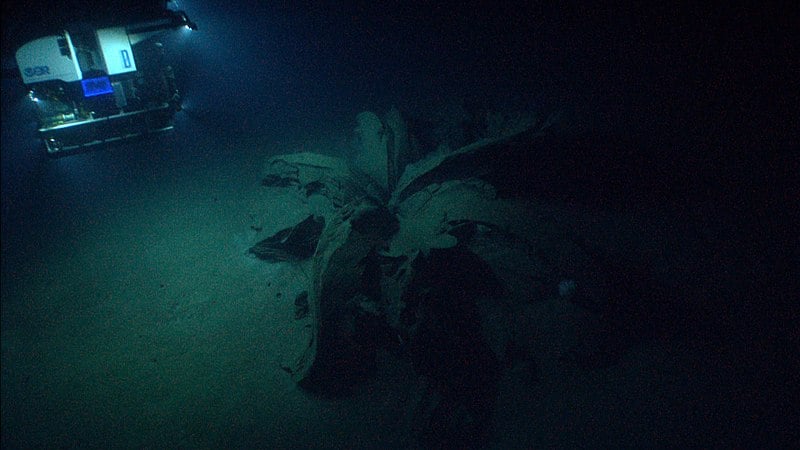
A better way to put it is that there have been changes in living creatures caused by the changes that happened to the Earth.
But what exactly are these changes that affected the planet?
The existence of mountains, the course of rivers, and the width of valleys have all changed and shifted over time, but in this article, we’re talking about even bigger changes. We’re going to talk about changes that gave the Earth its completely new faces over the course of history. We’re going to talk about continental drift!
Recommended Video for you:
Earth may look like one giant block of solid rock, but only some of it is solid and only some of it is rock.
Earth is made of many puzzle-like pieces called tectonic plates. The reason we know about this is because the west coast of Africa and the east coast of South America fit together like puzzle pieces. This is what led Alfred Wegner to first come up with the continental drift theory.
Then Wegner noticed something else that gave even more strength to his theory. Multiple fossils from opposite sides of the Atlantic Ocean showed similarities to one another. The only way this could be possible is if those places had once been joined together.
But how is it possible for a whole continent to move?
Also Read: What Is The Continental Drift Theory And How Is It Related To Plate Tectonics?
The Earth’s tectonic plates are part of the uppermost layer, called the crust. There are about 15-20 of these plates and they’re made of solid rock. But how does solid rock move around? Well, the crust rests on a layer of molten rock called the mantle, which is almost 3000 kilometers thick. Being that big, it has its own processes.
Radioactive processes take place within the mantle and cause the release of heat. The release of this heat happens unevenly and creates a conventional current. This means that there is a flowing current in the liquid mantle created by different temperatures. This flowing current is what causes the tectonic plates to move. You can read more about that phenomenon here .
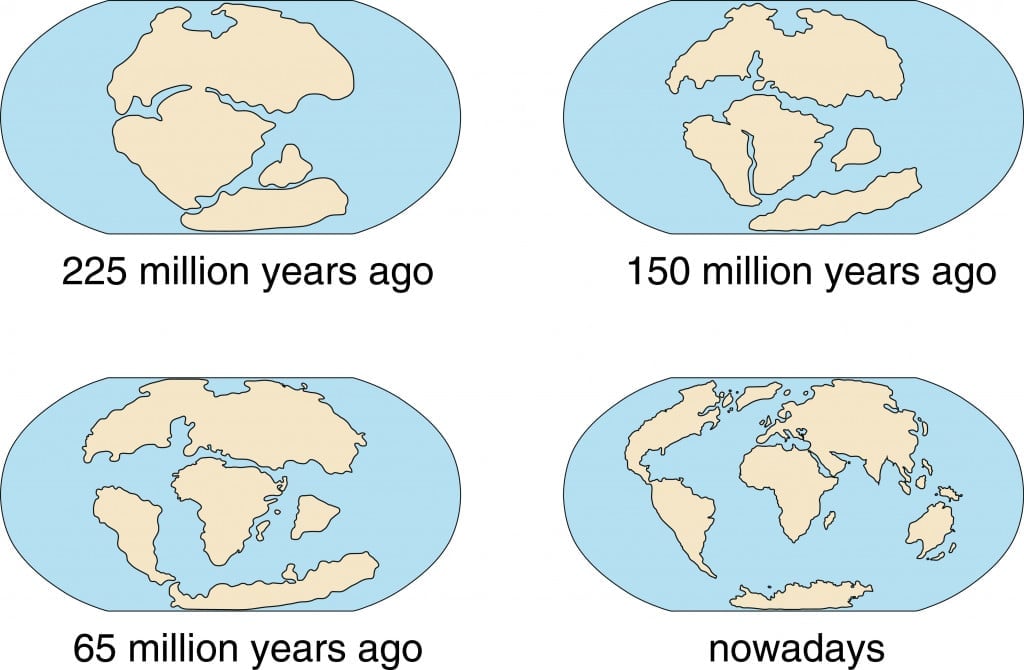
This causes the different plates to move at an average rate of 1.5 cm a year. This may not seem like much, but it makes a huge difference when you think about the age of Earth.
Also Read: What Are Subduction Zones?
Continental drift has played a large role in the evolution of life today. It has caused some very unique creatures to evolve from very different ancestors. It has also caused some species from the same place to diverge into many separate species.
Carried Across The Ocean
Have you seen the silly scenes from Ice Age: Continental Drift where Manny, Sid and Diego float on a small piece of land across the ocean? The idea may seem ridiculous, but in the grander scheme of things, it’s actually a comical and satirical depiction of what really happened.
The world once had a single large continent called Pangea. A single ocean, which we now call Panthalassa, surrounded the whole continent. This was around 250 million years ago. Life has existed on Earth for 3.5 billion years, and complex life with large creatures and complex ecosystems has been around for 540 million years. This means that the Earth had lots of wildlife before the continents began drifting apart.
As the continents eventually separated, some creatures that lived in places where the continents broke started to become different from each other.
Marsupials are a great example of different species that formed due to continental drift. Marsupials are pouched mammals, like kangaroos and koalas, but did you know about their famous American cousins, the opossums?
Well, believe it or not, but marsupials originally existed in America. At the time, all the southern continents were a part of one giant landmass called Gondwanaland. Eventually, as Gondwanaland split, the marsupials in Australia evolved to form pouches, while opossums evolved without very evident pouches (they do have tiny flaps, but they’re not nearly as prominent).
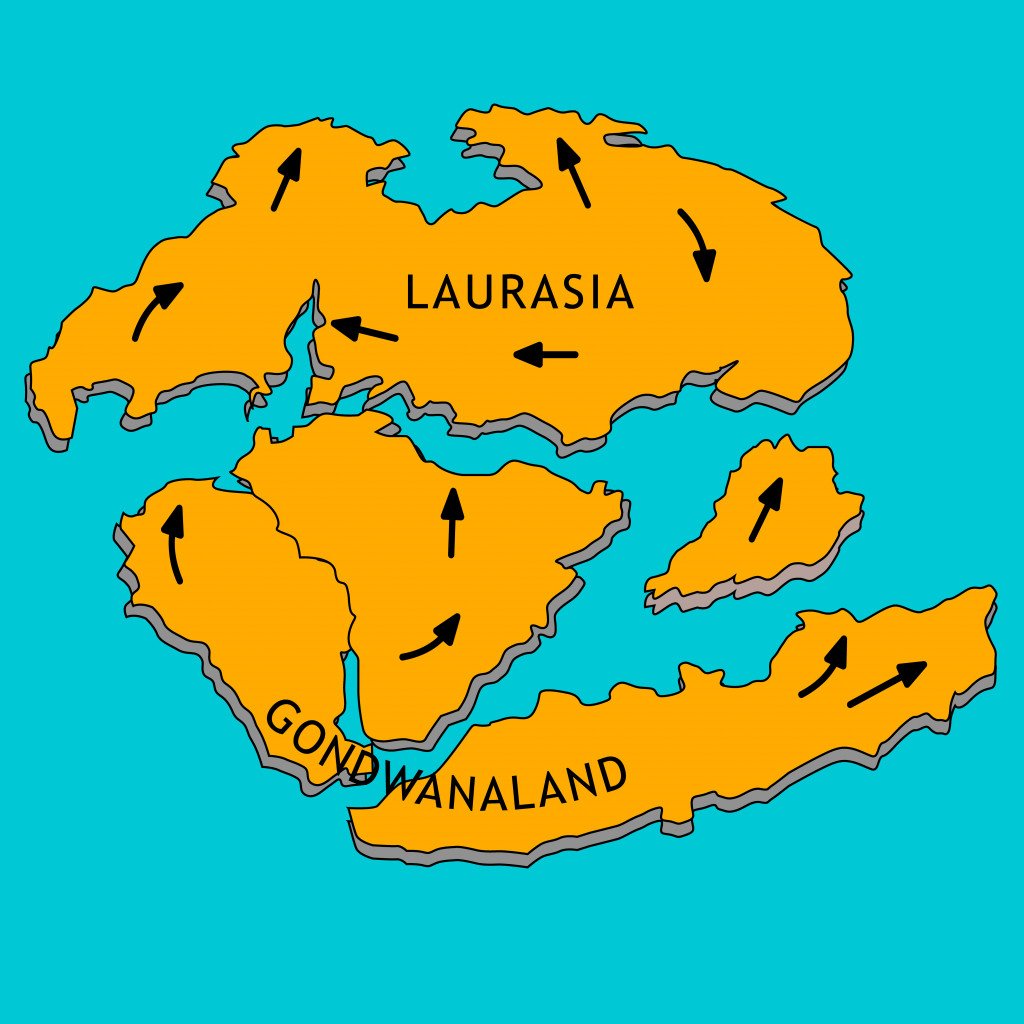
This is just one example. Anteaters on different continents have diverged only because of continental drift. On the flip side, the purple pig-nosed frog, which exists in India, has its closest ancestors in Madagascar, as that’s where it originated from before being carried away on the Indian subcontinent to Asia.
Creating Barriers
During the movement of tectonic plates, land masses did not just drift apart. There are some land masses that also crashed into each other. When these land masses crashed into each other, they formed mountains. An example of this is the ongoing formation and rise of the Himalayas.
When these mountains formed, they created barriers of separation. This means that some members of the same species were separated on either side of the mountain. In a similar way to how species diverge because of being carried away across water bodies, new species are also formed by the formation of mountains. You can read about those types of speciation events in the article here .
Continental drift is an ongoing process. Although we will never see measurable changes from it during our lifetime, it has directly influenced life on Earth today. By studying this process further, we should be able to predict how the face of the Earth will continue to change life on this planet in the future.
- Alfred Wegener: Building a Case for Continental Drift. The University of Illinois Urbana-Champaign
- Early Life on Earth – Animal Origins. The Smithsonian Institution
- What is the relation between continental drift and the evolution? How four very different kinds of ant/termite eaters could occur in India, Africa, South America, and Australia? - UCSB Science Line. The University of California, Santa Barbara
- What is a tectonic plate? [This Dynamic Earth, USGS]. The United States Geological Survey
- Introduction to geology : Read, H. H. (Herbert Harold), 1889-1970 : Free Download, Borrow, and Streaming : Internet Archive - archive.org
- What is Tectonic Shift? - NOAA's National Ocean Service. The National Ocean Service
- Plate tectonics and lava lamps - NOAA. The National Oceanic and Atmospheric Administration
- Biju, S. D., & Bossuyt, F. (2003, October). New frog family from India reveals an ancient biogeographical link with the Seychelles. Nature. Springer Science and Business Media LLC.
Mikhail Nazareth has a Bachelor’s degree in Chemistry, Botany and Zoology from Christ University, Bangalore. He is currently pursuing his Master’s of Marine Biology at James Cook University, Townsville, Australia. He loves exploring the wild and all the creatures in it. When he’s not crawling through forest shrubberies or looking into tidepools, he’s probably playing ultimate frisbee or jamming with his friends.
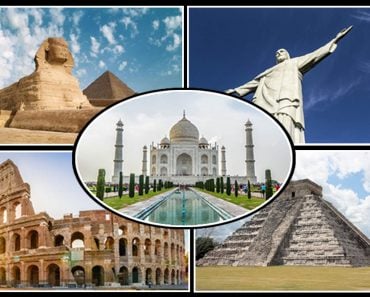
Does Continental Drift Have Any Effect On Manmade Structures?

Was The Earth Ever Totally Underwater?

Is The African Continent Splitting In Two?

Why Is The Atlantic Ocean Widening While The Pacific Ocean Is Shrinking?

Uniformitarianism Vs Catastrophism: Is The Earth Shaped By Violent Events Or Gradual Changes?
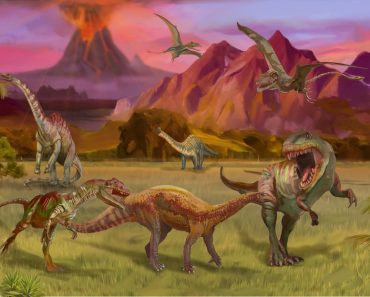
What Was Killing The Dinosaurs Before The Asteroid Fell?

Neanderthals Vs Homo Sapiens: Different Species Or Subspecies?

What Would Happen If Earth Rotated Faster?

What Separates Humans From Animals?

What Are Asteroids And Where Do They Come From?

What is Evolution: A REALLY SIMPLE and Brief Explanation

Biomes of the World: Oceans, Mountains, Forests, Grasslands, Deserts and More!

IMAGES
COMMENTS
continental drift, large-scale horizontal movements of continents relative to one another and to the ocean basins during one or more episodes of geologic time.This concept was an important precursor to the development of the theory of plate tectonics, which incorporates it.. The idea of a large-scale displacement of continents has a long history. Noting the apparent fit of the bulge of eastern ...
Continental drift describes one of the earliest ways geologists thought continents moved over time. Today, the theory of continental drift has been replaced by the science of plate tectonics.. The theory of continental drift is most associated with the scientist Alfred Wegener.In the early 20th century, Wegener published a paper explaining his theory that the continental landmasses were ...
Continental drift is the hypothesis, originating in the early 20th century, that Earth's continents move or drift relative to each other over geologic time. [1] The hypothesis of continental drift has since been validated and incorporated into the science of plate tectonics, which studies the movement of the continents as they ride on plates of the Earth's lithosphere.
After reviewing the scientific literature, he published a hypothesis stating the continents were originally connected and then drifted apart. While he did not have the precise mechanism worked out, his hypothesis was backed up by a long list of evidence. Figure 2.1.1 2.1. 1: Wegener later in his life, ca. 1924-1930.
Lisa Marder. Updated on July 24, 2019. Continental drift was a revolutionary scientific theory developed in the years 1908-1912 by Alfred Wegener (1880-1930), a German meteorologist, climatologist, and geophysicist, that put forth the hypothesis that the continents had all originally been a part of one enormous landmass or supercontinent about ...
Additional resources. Continental drift was a revolutionary theory explaining that continents shift position on Earth's surface. The theory was proposed by geophysicist and meteorologist Alfred ...
The continental drift hypothesis was developed in the early part of the 20th century, mostly by Alfred Wegener. Wegener said that continents move around on Earth's surface and that they were once joined together as a single supercontinent. ... until technological advances presented even more evidence that the continents moved and gave ...
Alfred Wegener died in 1930 on an expedition on the Greenland icecap. For the most part the continental drift idea was put to rest for a few decades, until technological advances presented even more evidence that the continents moved and gave scientists the tools to develop a mechanism for Wegener's drifting continents.
Developing the theory [This Dynamic Earth, USGS] Continental drift was hotly debated off and on for decades following Wegener's death before it was largely dismissed as being eccentric, preposterous, and improbable. However, beginning in the 1950s, a wealth of new evidence emerged to revive the debate about Wegener's provocative ideas and their ...
Continental drift. Continental drift is the movement of the Earth's continents relative to each other. The hypothesis that continents 'drift' was first put forward by Abraham Ortelius in 1596 and was fully developed by Alfred Wegener in 1912. However, it was not until the development of the theory of plate tectonics in the 1960s, that a ...
Theory of Continental Drift. The continental drift hypothesis was developed in the early part of the 20th century, mostly by Alfred Wegener. Wegener said that continents move around on Earth's surface and that they were once joined together as a single supercontinent. While Wegener was alive, scientists did not believe that the continents ...
Alfred Wegener died in 1930 on an expedition on the Greenland icecap. The continental drift hypothesis was put to rest for a few decades. Only when technology could provide even more evidence for continental drift did scientists look into the idea again. Technology also helped scientists to develop a mechanism for how continents could drift.
Alfred Wegener in Greenland. Plate tectonics is the theory that Earth's land masses are in constant motion. The realization that Earth's land masses move was first proposed by Alfred Wegener, which he called continental drift. He is shown here in Greenland. We don't perceive that the continents we live on are moving.
Continental drift. During the 20th Century, scientists developed the theory of Plate Tectonics. The theory suggests that the crust of the Earth is split up into seven large plates (see map below) and a few smaller ones, all of which can slowly move around on the Earth's surface. They lie on the ductile mantle that allows them to move.
The continental drift hypothesis was developed in the early part of the 20 th century, mostly by Alfred Wegener. Wegener said that continents move around on Earth's surface and that they were once joined together as a single supercontinent. While Wegener was alive, scientists did not believe that the continents could move.
Wegener's theory of continental drift states that the existing continents of the earth were once glued together forming a super landmass. Over time, the landmass broke and drifted away and is still drifting to this day. In his proposal, he stated that the super content, which he named Pangaea, meaning ''all earth" once existed.
Explore the origins of the theory of continental drift and uncover the true discoverer behind this groundbreaking concept in Earth science.
Another important piece of evidence in the Continental Drift theory is the fossil relevance. There are various examples of fossils found on separate continents and in no other regions. This indicates that these continents had to be once joined together because the extensive oceans between these land masses act as a type of barrier for fossil ...
Theory of Continental Drift. The continental drift hypothesis was developed in the early part of the 20th century, mostly by Alfred Wegener. Wegener said that continents move around on Earth's surface and that they were once joined together as a single supercontinent. While Wegener was alive, scientists did not believe that the continents ...
The theory of continental drift was also instrumental in developing another theory—that of plate tectonics, which explains that the movement of large sections of Earth's crust, called tectonic plates, causes changes in Earth's surface. Today, plate movements are thought to shift Earth's continents about 2 centimeters (or 0.8 inch) per year.
Alfred Wegener's Continental Drift Hypothesis. Alfred Wegener (1880-1930) was a German scientist specializing in meteorology and climatology. His knack for questioning accepted ideas started in 1910 when he disagreed with the explanation that the Bering Land Bridge was formed by isostasy and that similar land bridges once connected the continents.
But the concept of plate tectonics and the theory of continental drift that preceded it were quite radical. It took almost a century to develop and confirm the theory, and it was not widely accepted even among scientists until the 1960s. This is a brief story of how the theory evolved and why there was so much resistance. (additional text under ...
Countless different related species are the result of continental drift. The first evidence of life on Earth can be seen as far back as 3.7 billion years ago, which is an unimaginable amount of time. However, life has changed a lot since then. Along with changes to living creatures, there have also been changes in how the Earth looks.
New model refutes leading theory on how Earth's continents formed. ScienceDaily . Retrieved August 12, 2024 from www.sciencedaily.com / releases / 2024 / 08 / 240805134131.htm